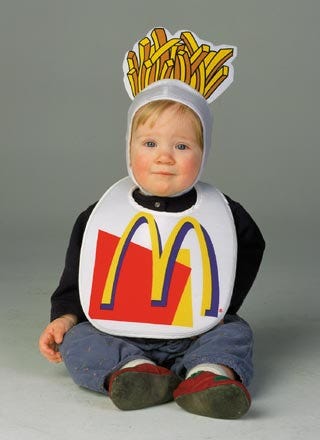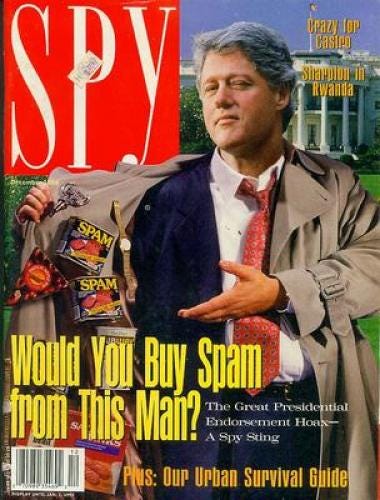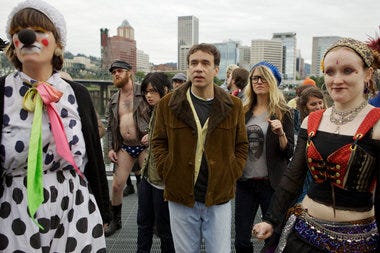So What, Who Cares (vol 2, issue 20) Why the dream of the '90s is alive

Hello! I very much appreciated your replies on the french fry question -- steak fry fans do exist in the wild! Who knew? -- and your taking the time to respond was a great wrap-up to last week.
I will refrain from further fry monologues, mostly because it seems really cruel to the readers who are snowed in right now, unless you own your own deep-frying apparatus and have nothing but free time, a sack of potatoes and a whole lot of peanut oil. In that case, I salute your preparedness.
What are the must-haves among your emergency supplies? Coffee and a manual grinder? A whole lot of Nutella? A stash of books you've always wanted to get around to? Earplugs to block the witterings of your roommates? Help us all prep better for whatever nature flings our way via Twitter or email.
*
The dream of the nineties is alive for pundits. Back in September, the U.S. government did an economic data dump concluding that verily, the middle class's earning power in the 1990s and it has been a brutal slide downhill ever since. The culprit? As Annie Lowrey explains in "Will the Economy Ever Be As Good As It Was in the ’90s?"
The root causes include technological change, the decline of labor unions, and globalization, economists think, though they disagree sharply on how much to weight each factor. But foreign-produced goods became sharply cheaper, meaning imports climbed and production moved overseas. And computers took over for humans in many manufacturing, clerical, and administrative tasks, eroding middle-class jobs growth and suppressing wages.
So the answer to the headline question is pretty much "No." All hail our robot overlords!

But wait! There's more. Last Sunday, Kurt Anderson, formerly of the ur-snark publication Spy magazine, issued the exuberantly nostalgic "The Best Decade Ever? The 1990s, Obviously," and outlined all the ways in which that decade excelled: booming job creation; the number of "free" nations in the world increasing from 65 to 85; David Foster Wallace's Infinite Jest; a notable lack of kids on his lawn, etc.
Truly, it was the golden age, ushered in by supermodels dancing around in their underwear and ending with The Sopranos promising a renaissance on the remote control. Let's just ignore the looming technological changes that characterized the decade, or the decline of labor unions, or the rise of globalization!
So what? The same 1990s that saw freedom ringing throughout the world also saw inflamed racial tensions in the U.S., the ugly sexual theater surrounding Anita Hill and Monica Lewinsky, and the passage of the Financial Services Modernization Act of 1999, a piece of legislation that effectively led to the 2008 bank crash.
Nostalgia is the first step in altering an historical record, and it's a handy way to work out today's tensions through a reassuring scrim of "And it all worked out."
Who cares? Op-ed page editors around the country, who should shut this 1990s nostalgia down before some block in Seattle is turned into the moral equivalent of the corner of Haight and Ashbury. Casting a gimlet eye at this La Belle Epoque spin on the 1990s may also help news junkies filter through the noise of the pending '16 elections.

Bonus viewing: Portlandia's musical sketch, "The Dream of the Nineties," is quite possibly a perfect Gen X artifact: simultaneously indulging in nostalgia while eye-rolling at what the 1990s wrought with classic slacker detachment.
Bonus eye candy: This round-up of photos taken during 1994's New York fashion week -- with Tupac Shakur, Mariah Carey in the ubiquitous cropped-sweater-and-kilt look and Richard Gere looking like he's thinking real hard about Tibet -- are a great way to go time-traveling without leaving your Web browser.
*
There are eight biological indicators that suggest a cancer patient will die within 72 hours, claims a study published this week in Cancer. They are: non-reactive pupils, the inability to close one's eyes, grunting of vocal cords; upper gastrointestinal bleeding; decreased response to verbal stimuli; drooping of the nasolabial fold; hyperextension of the neck; decreased response of visual stimuli.
So what? Study author David Hui, M.D., explains why this is useful information:
"Equipped with this information, family caregivers may have a greater sense of control during this time of uncertainty, and will be able to better plan care for the patient and themselves in regard to family visits, overnight stays, and time off work."
Who cares? Many, many people might. The American Cancer Society estimates that this year, 1.65 million new cases of cancer will be diagnosed, and nearly 590,000 people will die of some form of cancer (so, 1600 cancer deaths per day). Few of those deaths will happen in a vacuum. That's a lot of of caregivers and loved ones who may want or need a timetable. These new clinical signs can provide some clarity.
Bonus reading: "How not to say the wrong thing" is an indispensable guide for not being a massive jerkstore to people when they're stricken with an illness. Learn the Ring Theory -- "Comfort in, dump out."
*

Your pop culture note of the day: My friend Miki lent me D.V. by Diana Vreeland (with George Plimpton) last Thursday and once I came across the line, "Nostalgia – imagine! I don’t believe in anything before penicillin," I was transfixed.
Patton Oswalt once described Robert Evans' The Kid Stays In the Picture thusly: "It's like listening to Lucifer dictate his memoirs on a Sunday afternoon -- you know, lying on his couch in a bathrobe, with a martini on his belly ..." This book -- D.V. -- is the distaff equivalent. That's a compliment.
(For those of you who are all, "Diana Who?" here is all you need to know about her: She was the Steve Jobs of American women's-magazine editors.)
One of the things that was striking about the book was the immediacy and modernity of the authorial voice; I am honestly surprised nobody is tweeting this book a line at a time, it's that fresh. The other thing that I am still marveling at is how skillful George Plimpton was in assembling the material and using it to illuminate the subject in ways she may not have intended. The last chapter allows a long, lingering look beneath the edifice of Vreeland's invented self, and the final paragraphs are among some of the most poignant I've read.
Used copies of D.V. are available in abundance on Amazon. It's a lovely literary lagniappe.
*
Did you miss an issue of So What, Who Cares? The archive is here. Are there typos? I apologize in advance.
As always, I welcome your feedback and suggestions -- you can reach me through Twitter or email. Please do not hesitate to let me know what you think about So What, Who Cares, or suggest links/topics/pop culture that rings your bell.
If you really like it, tell a friend to subscribe.


